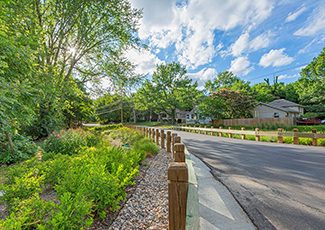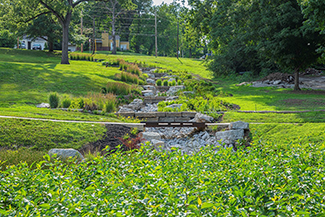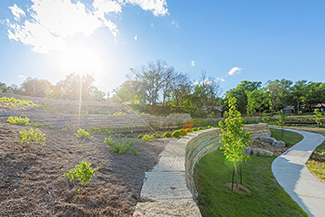Target Green Marlborough
Kansas City, Missouri



How does this project advance the three pillars of sustainability — social equity, economic vitality and environmental stewardship?
Social Equity: The Target Green Marlborough green infrastructure projects support community goals defined in the Marlborough Community Coalition’s Catalyst Plan, while improving the infrastructure system. The city’s Green Stewards workforce development program is supporting preventative maintenance activities in the area, necessary for the function of the green infrastructure.Economic Vitality: The Target Green Marlborough green infrastructure project included defining the use of green space in the area, building a strong foundation for commercial and economic growth in the future. This has included defining the use of previously vacant, overgrown property at 81st and Troost, enhancing features at existing Arleta park for multiple uses, and defining new areas of connecting with nature at Rachel Morado park.
Environmental Stewardship: Water pollution is reduced by lowering the volume of surface water runoff discharging into combined sewer systems, thus reducing discharges of polluted water containing untreated or partially treated human and industrial waste, toxic materials, and debris to the Blue River. Through this project, the risk of downstream surface flooding and resulting environmental damage is reduced because of lower runoff rates and volumes. The green infrastructure improvements stimulate natural groundwater recharge to benefit aquifers and river baseflows, as well as create new green space within the neighborhood for multiple community benefits.
Project Goals:
-
This project is part of Kansas City’s Smart Sewer program. It included the following main green infrastructure features: wetland/detention at 81st and Troost Avenue, bioretention at Arleta park, Rachel Morado, The Paseo medians and 81st and Lydia. Multiple infrastructure benefits beyond reducing the frequency of sewer overflows have been realized through this project. These improvements span city departments and include:
- Addition of 25 acres of usable greenspace.
- 400 trees planted.
- Rehabilitation of 20,000 linear feet of sewer.
- Replacement of 15,000 linear feet of water mains.
- Street resurfacing.
- Flood control through extended detention and improved storm sewer.
- 5 miles of sidewalks/trails.
Project Description:
The Target Green Marlborough green infrastructure projects expanded on the construction of the pilot project in the Marlborough Neighborhood of Kansas City, Missouri. Through citywide collaboration, the project has served as a catalyst for leveraging the green infrastructure investment to further advance reducing sewer overflows, while setting the stage for future improvements that could further enhance the livability and safety of the community. The project expanded on the pilot project’s distributed green infrastructure facilities by designing and constructing neighborhood and central green infrastructure in an urbanized environment. The variety of green infrastructure practices in the Marlborough area allows the city to evaluate the implementation of multiple levels of green infrastructure, while integrating into the existing fabric of the community. Green infrastructure practices include a wetland, multiple bioretention facilities and permeable pavers. These improvements have provided a base for future community amenities that are currently in the planning and design stages, including improved pedestrian access, nature viewing stations and a playground facility.
Community Benefits and Lessons Learned:
The project is a result of significant public and private investments, passionate leadership and community engagement. These extraordinary efforts go back more than a decade when the city of Kansas City began engaging with community leaders and stakeholders to find ways to leverage the infrastructure investment to the maximum extent possible. The city began by implementing multiple types of green infrastructure improvements within a 100-acre pilot project area. This pilot project provided the project team with valuable insight regarding the performance of various types of green solutions at a distributed scale. These lessons learned were then applied on a larger scale throughout the remaining 644 acres of the watershed through this project, where neighborhood and centralized green infrastructure was integrated into the area. The city continues to learn through designing and building green infrastructure and is translating these lessons into the Green Stormwater Infrastructure Manual, and into the implementation of preventative maintenance tasks by the city Green Solutions crew, the city Green Stewards and community volunteers.
Funding Sources and Partnerships:
Inter-departmental collaboration among the City Manager’s Office, Water, Parks, Planning and Development, Public Works, and Neighborhood Services departments have resulted in improvements to streets, parks, water and sewer infrastructure. The investments made in this project attracted a partnership with The Heartland Conservation Alliance and The Conservation Fund’s Parks with Purpose program. Grant funding will add a layer of conservation education to the greenspace at 81st Street and Troost Avenue through the addition of four “Nature Nodes” and enhanced native landscape plantings.
